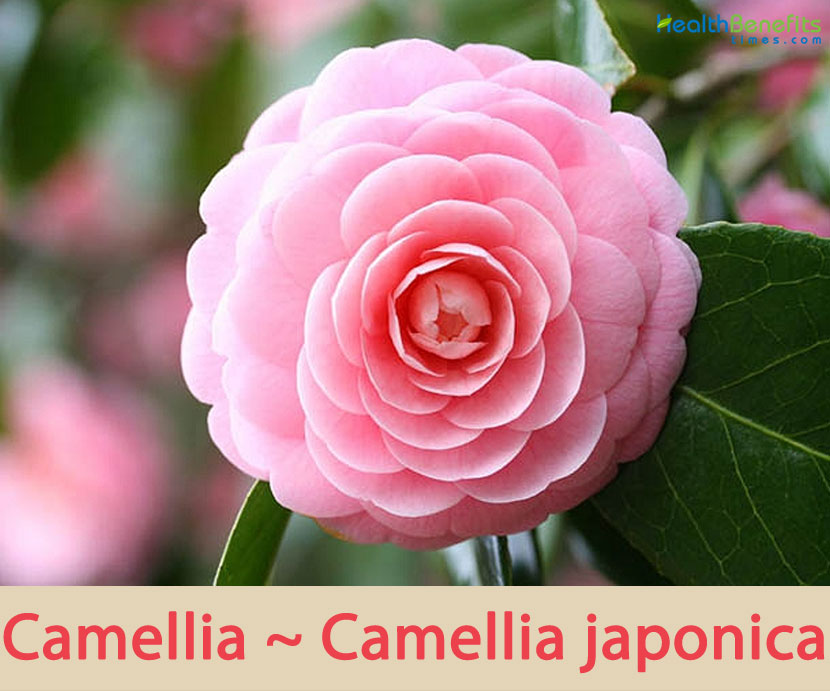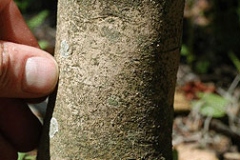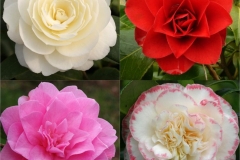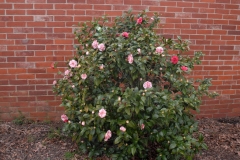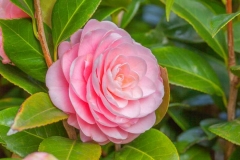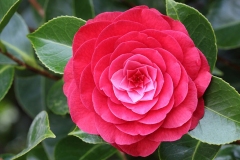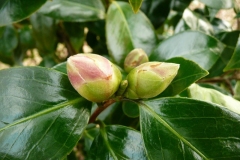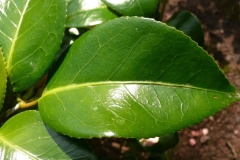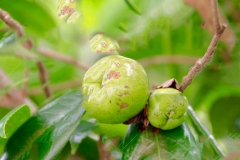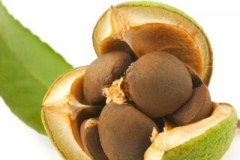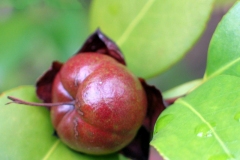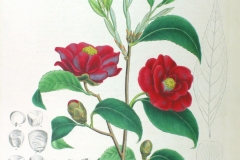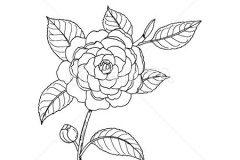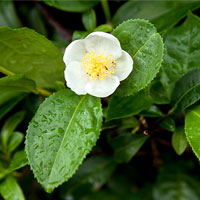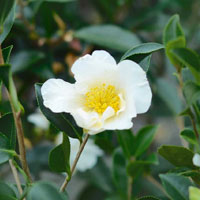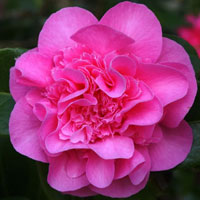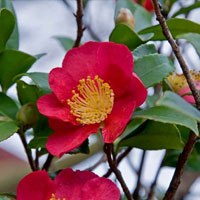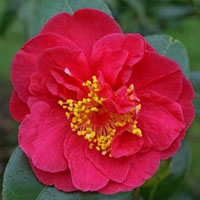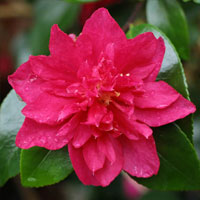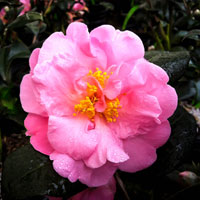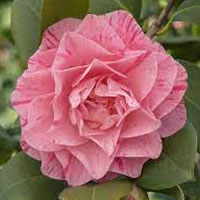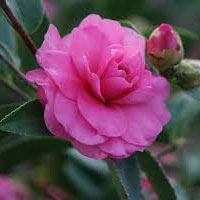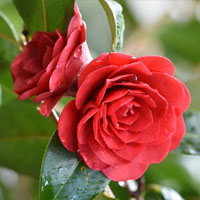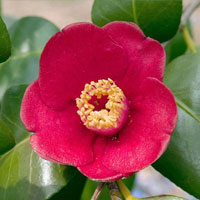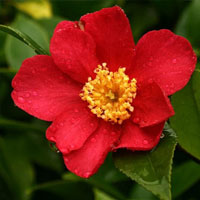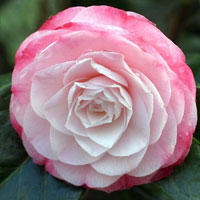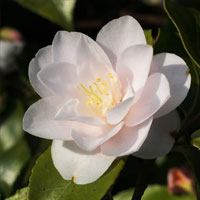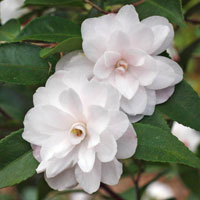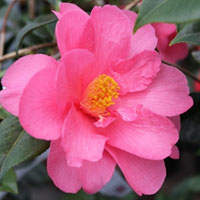The genus Camellia was named after a Jesuit priest and botanist named Georg Josef Kamel (1706), a Jesuit missionary and naturalist who introduced Philippine flora to Europe. The specific epithet japonica was given to the species by Carl Linnaeus in 1753 because Engelbert Kaempfer was the first to give a description of the plant while in Japan. There are over 2,000 named cultivars of Japanese Camellia with many colors and forms of flowers, and more are developed each year. In the U.S. it is sometimes called japonica, a name more often used in the UK for Chaenomeles (flowering quince). Camellia attracts pollinators and songbirds and is at home in an Asian garden, children’s garden, edible garden, or pollinator garden.
Camellia Facts
| Camellia Quick Facts | |
|---|---|
| Name: | Camellia |
| Scientific Name: | Camellia japonica |
| Origin | Eastern and Southern Asia, most notably China (Shandung), Taiwan, Japan (except Hokkaido), Korea, India and Indonesia |
| Colors | Initially green but ripening in the fall to a light brown |
| Shapes | Globe-shaped capsule with three compartments (locules), each with one or two large brown seeds |
| Health benefits | Beneficial for burns, scalds, hematemesis, oketsu syndrome, asthma, cardiovascular disorders, blood sugar levels, cholesterol levels, arthritis, cold and flu |
| Name | Camellia |
|---|---|
| Scientific Name | Camellia japonica |
| Native | Eastern and Southern Asia, most notably China (Shandung), Taiwan, Japan (except Hokkaido), Korea, India and Indonesia |
| Common Names | Camellia, Common Camellia, Japanese Camellia, False flax, Gold of pleasure, Kamelia jepang, Mawar musim dingin, Rose of winter, Shancha, Siberian oil seed, Trahoa nhat, Tsitsmati, Camellia Albino Botti, Camellia Don Pedro, Camellia Eugene De Massina, Camellia Princess Mary, Donckelaer’s Japanese Camellia |
| Name in Other Languages | Afrikaans: Camellia Albanian: Camellia Amharic: Kamēlīya (ካሜሊያ) Arabic: Alkamilia (الكاميلية) Armenian: Kamelia (կամելիա) Azerbaijani: Kameliya, Yapon kameliyası Basque: Camellia, Japoniako kamelia Belarusian: Kameliya (камелія) Bengali: Camellia, Kyāmēliẏā (ক্যামেলিয়া) Bosnian: Kamelija Brazil : Camellia, Rosa-Do-Japão Breton: Roz-kamelia Bulgarian: kameliya (камелия), obiknovena kameliya (обикновена камелия) Catalan: Camèlia Cebuano: Camellia Chichewa: Camellia Chinese: Cháhuā (茶花), Shan Cha (山茶), Yuan Bian Zhong, Sazanka(山茶花), Nihon Tsubaki (日本山茶) Corsican: Camellia Croatian: Kamelija Czech: Kamélie, Kamélie Japonská Danish: Camellia, Ægte Kamelia, Kamelia Dutch: Camellia English: Camellia, Common camellia, Japanese camellia, Camellia Albino Botti, Camellia Don Pedro, Camellia Eugene De Massina, Camellia Princess Mary, Donckelaer’s Japanese Camellia, Esperanto: Kamelio, Japana kamelio Estonian: Kameelia, Jaapani Kameelia Filipino: Kamelya Finnish: Kamelia French: Camélia , Camélia, Camélia Du Japon, Rose Du Japon Frisian: Camellia Galician: Camelia Georgian: K’amelia (კამელია) German: Kamelie, Japanische Kamelie Greek: Kamélia (καμέλια) Gujarati : Kēmēlīyā (કેમેલીયા) Haitian Creole: Kamelya Hausa: Camellia Hawaiian: Kamela Hebrew: קמליה Hindi: Kameelaya (कमीलया) Hmong: Camellia Hungarian: Kamélia, Japán kamélia Icelandic: Camellia Igbo: Camellia Indonesian: Bunga kamelia Irish: Camellia Italian: Camellia, camelia comune Japanese: Kameria (カメリア), Tsubaki, Housan tsubaki (ホウサンツバキ),Taiwan yama tsubaki (タイワンヤマツバキ), Tsubaki (ツバキ), Yabu tsubaki (ヤブツバキ), Yama tsubaki, Tsubaki (椿) Javanese: Camellia Kannada: Kemeliyā (ಕೆಮೆಲಿಯಾ) Kazakh: Camellia Khmer: Camellia Kinyarwanda: Ingamiya Komi: Kameliya (Камелия) Korean: Dongbaeg namu (동백 나무), Dong-Baek-Na-Mu, Tteul-Dong-Baeng- Na-Mu Kurdish (Kurmanji): Camellia Kyrgyz: Camellia Lao: Camellia Latin: Camellia Latvian: Kamēlija Lithuanian: Kamėlija, Japoninė kamelija Luxembourgish: Kamellen Macedonian: Kamelija (камелија) Malagasy: Camellia Malay: Bunga kamelia Malayalam: Camelli’a (ചമെല്ലിഅ), kāmiliya (കാമിലിയ) jāpēānika (ജാപോനിക) Maltese: Sinensis Maori: Camellia Marathi : Camellia Mongolian: Camellia Myanmar (Burmese): Camellia Nepali: Camellia North Frisian: Kameelie Norwegian: Camellia, Kamelia Odia: କ୍ୟାମେଲିଆ | Pashto: کمیلیا Persian: درخت و گل کاملیا Polish: Kamelia, Kamelia Japonska Portuguese: Camélia, Rosa-do-japão, cameleira, camélia-japonesa, japoneira, roseira-do-Japão Punjabi: Kaimili’ā (ਕੈਮਿਲਿਆ) Romanian: Camelia Russian: Kameliya (камелия), Kameliia Iaponskaia, Kameliia iaponskaia (Камелия японская) Samoan : Kamela Scots Gaelic: Camellia Serbian: Kamelija (камелија) Sesotho : Camellia Sindhi: ڪيمليه Sinhala: Kæmīliyā (කැමීලියා) Slovak: Kamélie, kamélia japonská Slovenian: Kamelija Shona: Camellia Somali: Camellia Spanish: Camelia, Japonska kamelija, camelio común Sudanese: Kamelia Swahili: Camellia Swedish: Kamelia, Tebuske Tajik: Camellia Tamil: Kamēliyā (கமேலியா) Tatar: Kamelliya (камеллия) Telugu: Kāmelliyā (కామెల్లియా) Thai: Dxk khemī leīy (ดอกเคมีเลีย), Tæ̂ ḥwy (แต้ฮวย) Turkish: Kamelya, Japon kamelyası Turkmen: Kamelýa Udmurt: Kameliya (Камелия) Ukrainian: Kameliya (камелія), Kameliya yaponsʹka (Камелія японська) Upper Sorbian: Japanska kamelija Urdu: کے Camellia Uyghur: تۆگە Uzbek: Kameliya Vietnamese: Hoa camellia, Sơn trà Nhật Bản Welsh: Camellia Xhosa: Camellia Yiddish: Kamellia (קאַמעלליאַ) Yoruba: Camellia Zulu: Camellia |
| Plant Growth Habit | Evergreen, branched, glabrous perennial shrub or small tree |
| Growing Climates | Forests, garden, Woods in hills, down to sea level near the coast |
| Soil | Should be planted in the shade in organic, somewhat acidic, semi-moist but well drained soil. If the soil is not well drained, it can cause the roots to rot |
| Plant Size | Can reach between 7 to 12 feet (2-3.6 m) in height and 5 to 10 feet (1.5-3 m) in width. Some varieties have grown much taller than usual at about 36 feet (11 m) |
| Bark | Smooth light brown to gray-brown |
| Branches | The youngest branches are purplish brown, becoming grayish brown as they age |
| Twigs | Moderately stout, light brown, glabrous; flower buds quite large (3/4 inch) with imbricate scales, fuzzy greenish brown, vegetative buds much smaller |
| Leaf | Alternately arranged leathery leaves are dark green on the top side, paler on the underside, usually 5–11 centimeters (2.0–4.3 in) long by 2.5–6 centimeters (1.0–2.4 in) wide with a stalk (petiole) about 5–10 millimeters (0.2–0.4 in) long. The base of the leaf is pointed (cuneate), the margins are very finely toothed (serrulate) and the tip somewhat pointed |
| Flowering season | From November to March with the peak of bloom in January and February |
| Flower | Solitary in 2–5 flowered sub terminal clusters. Flower bracteoles 9–13, deciduous, globose, ovate, subglobose; sepals, 9–13, globose, ovate, 2–20 mm long; petals 5–7 obovate, broadly obovate, retuse, round, 30–45 mm long, white, pink, red, variegated or variously coloured. Stamens 25–35 mm long, basal half of outer filaments connate, not forming a tube; style, trifid; ovary ovate and 3-locular |
| Fruit Shape & Size | Globe-shaped capsule with three compartments (locules), each with one or two large brown seeds |
| Fruit Color | Initially green but ripening in the fall to a light brown |
| Seed | Large brown seeds with a diameter of 1–2 centimeters (0.4–0.8 in) |
| Varieties |
|
| Propagation | By seeds, softwood cuttings, air-layering and grafting |
| Lifespan | 100 to 200 years in the wild |
| Season | September to October |
Plant Description
Camellia is an evergreen, branched, glabrous perennial shrub or small tree that can reach between 7 to 12 feet (2-3.6 m) in height and 5 to 10 feet (1.5-3 m) in width. Some varieties have grown much taller than usual at about 36 feet (11 m). The plant is found growing in forests, garden, woods in hills, down to sea level near the coast. It should be planted in the shade in organic, somewhat acidic (pH 5.5 to 6.5), and semi-moist but well drained soil. If the soil is not well drained, it can cause the roots to rot. They are slow to grow and slow to establish but are long-lived plants.
Because plants are slow to establish, it is best to dig a large hole, three to four times wider, but not deeper, than the root ball, to reduce competition for water and nutrients from surrounding trees and shrubs. Excess sun, cold, or shade can reduce flowering. Twigs are moderately stout, light brown, glabrous. Flower buds are quite large (3/4 inch) with imbricate scales; fuzzy greenish brown, vegetative buds are much smaller. The youngest branches are purplish brown, becoming grayish brown as they age. Bark is smooth light brown to gray-brown.
Leaves
Alternately arranged leathery leaves are dark green on the top side, paler on the underside, usually 5–11 centimeters (2.0–4.3 in) long and 2.5–6 centimeters (1.0–2.4 in) wide with a petiole about 5–10 millimeters (0.2–0.4 in) long. Base and the tips of the leaf is pointed (cuneate) and the margins are very finely toothed and the tip somewhat pointed.
| Leaf arrangement | Alternate |
| Leaf type | Simple |
| Leaf margin | Serrate |
| Leaf shape | Elliptic (oval) |
| Leaf venation | Pinnate |
| Leaf type and persistence | Evergreen |
| Leaf blade length | 2 to 4 inches |
| Leaf color | Green |
| Fall color | No fall color change |
| Fall characteristic | Not showy |
Flower
In the wild, flowering is between January and March. The flowers appear along the branches, particularly towards the ends, and have very short stems. They occur either alone or in pairs, and are 6–10 centimeters (2.4–3.9 in) across. There are about nine greenish bracteoles and sepals. Flowers of the wild species have six or seven rose or white petals, each 3–4.5 centimeters (1.2–1.8 in) long and 1.5–2.5 centimeters (0.6–1.0 in) wide. The innermost petals are joined at the base for up to a third of their length. (Cultivated forms often have more petals.) The numerous stamens are 2.5–3.5 centimeters (1.0–1.4 in) long, the outer whorl being joined at the base for up to 2.5 centimeters (1.0 in). The three-lobed style is about 3 centimeters (1.2 in) long. The most common forms in which their flowers appear are single, semi-double, or double with extra petals. They come in various shades of red, orange, yellow, lavender, pink, or white.
| Flower color
|
Orange; pink; red; yellow; lavender |
| Flower characteristic | Spring flowering; winter flowering |
Fruit
Fertile flowers are followed by globe-shaped capsule with three compartments (locules), each with one or two large brown seeds with a diameter of 1–2 centimeters (0.4–0.8 in). Fruiting occurs in September to October in the wild. Squirrels and Blue Jays often consume the seed, and are responsible for dispersing them.
| Fruit shape | Round |
| Fruit length | 0.5 to 1 inch |
| Fruit cover | Dry or hard |
| Fruit color | Green |
| Fruit characteristic | Inconspicuous and not showy |
History
The great Swedish botanist Linnaeus, named the camellia for Georg Joseph Kamel, a Jesuit botanist, who knew nothing of the plant, but made important collecting trips to the Philippines in the 1600s. The first camellia to arrive in England in 1705 died in a nobleman’s overheated hothouse. Fortunately, cuttings had been taken from the plant and were successfully grown on. Camellias arrived in the U.S. in the late 18th century, brought by French royal botanist Andre Michaux, who gave some to Henry Middleton, owner of a South Carolina plantation. More than 200 years later, one of those original camellias is still flourishing.
Best Camellia Varieties
Camellia Sinensis
Camellia sinensis is the tea shrub. It grows leaves that can be used for white, green, black, and oolong tea. It takes 3 years of growth for the shrub to reach full maturation and be ready for tea leaf harvesting. Don’t let that discourage you from growing one. Caring for your camellia sinensis is not hard, because the plant is hardy. Once the three years are up you will be able to regularly harvest tea throughout the rest of the shrub’s life, which could be as long as 50 years. If you were looking to grow camellia flowers, this shrub also has those. Dainty, small white and pink flowers bloom on the shrub.
Setsugekka
Wavy white petals of the setsugekka look as fragile as tissue paper. The petals sprout out of bright yellow stamens in their center, which provide a pop of color to this pristine flower. This camellia sasanqua is perfect to grow along walls and fences, its dark green foliage pleasantly blanketing them. The calming fragrance it emits will delight visitors of your garden. Be wary of keeping it in full sun because it is sensitive to heat. It prefers slightly acidic soil that should always be kept moist.
Debbie
It is perfect for pink-lovers; the bright pink petals of Debbie’s flowers are absolutely gorgeous. Their pop of color is all the more dramatic when contrasted with the glossy green foliage behind the flowers. Debbie is a camellia x williamsii hybrid, which means that it has glossy leaves and is extremely resilient against the cold. Camellia x williamsii hybrids are one of the easiest camellia species to grow because they have been bred for dependability.
Yuletide
Yuletide is a classic and gorgeous camellia that will set your heart ablaze. This dark green camellia bush is set alight when its fiery scarlet red flowers with yellow centers blossom in the winter. This plant is camellia sasanqua that can grow to be up to 10 feet tall. It is a hardy grower so it requires regular pruning to monitor its size and shape.
Australis
Australis camellia grows flowers with petals that are a brilliant shade of rose-red. Their dark green leaves are striking throughout the year even when the flowers aren’t in bloom. This plant is a camellia japonica that prefers full sun for a few hours a day, but also partial shade. If you prune it after it flowers each season it should remain the perfect size. It is very sensitive to cold and wind though, so be careful where you plant it, but otherwise, it is extremely easy to grow.
Lavinia Maggie
This award-winning camellia japonica has deep pink markings on pristine white petals. The petals are notably large, growing to be 5 inches in width. This elegant flower is simultaneously sophisticated and eye-catching. Keep it away from cold winds and it will thrive, growing to a maximum height of 10 feet.
Bonanza
This camellia sasanqua is short, only growing to be about 6 feet in height, but packs a visual punch with its bright-red fluted blooms circling a bright yellow stamen. While it doesn’t grow much vertically, it can horizontally spread up to 8 feet. It should be in either sun or partial shade, and special attention should be paid to keeping its roots moist. This fall flower emits a beautiful aroma and is an excellent option for container growing.
Pink Icicle
Other than having an incredible name, the pink icicle has a lot going for it. Its awesome soft and bright pink petals surrounding gorgeous yellow stamens in a peony-form make it one of the coolest camellias to grow. It grows very fast and thrives when grown in screens or hedges. This cold-weather-loving plant is also capable of thriving in zone 6 because it was bred for cold resilience.
Carter’s Sunburst
While its name is confusing, the fact that this camellia japonica has won several awards. It has beautiful soft-pink petals with raspberry-pink marking dotting them. It has a long blooming season, possessing flowers for ⅓ of the year, which is great because you will never want these flowers to go away. This incredible plant can grow to be 8 feet tall and 8 feet wide.
Chansonette
Chansonette is one of the most popular kinds of camellias to grow. This is in part due to it lasting a long time, and partly due to its stunning flower with lavender-pink frilled petals. It is a camellia hiemalis which means it blooms quickly in fall and maintains a bushy, medium-sized appearance. It grows to be only 3 feet tall which makes it an excellent container garden option. This award-winning camellia also works well for borders and hedges.
Les Jury
If you love roses, then you will love this camellia x williamsii. Its crimson-red flower petals arranged in a double-bloom form look just like roses. It can grow to be up to 6 feet in height and looks absolutely gorgeous when grown in containers. Particularly, its leaves start out bushy and bronze but mature into a dark green color that they maintain all year long. Les Jury is comparatively easy to grow and has a long growing season.
Korean Fire
The dark red funnel-shaped petals of Korean Fire are made all the more striking when juxtaposed with their bright yellow center. This striking camellia japonica can grow to be 15 feet in height, its dark, glossy leaves making it an excellent addition to borders and hedges. Use root mulch to keep this camellia looking its best.
Crimson King
This camellia sasanqua will be the king of your garden with large, 5-inch-wide bright red and pink petals surrounding a golden center. It blooms early and can grow to a maximum height of 12 feet when treated well. You should keep your crimson king in full sunlight, and make sure its roots are always moist. Treat your crimson king like a king and it will supply you with tons of eye-catching flowers!
Desire
Once you see the beautiful pale bluish-pink double petals of this camellia japonica, it will be the only camellia plant you desire. The unusual light color of Desire’s flowers fades into a deeper pink on its edges, giving it a soft yet striking look. It can grow to up to 10 feet tall and is a particularly resilient plant. It will continue to bloom for several months from early to mid-season.
Spring Mist
This camellia hybrid is as soft and subtle as a spring mist with petals that are tainted slightly blush-pink. Spring mist has small semi-double flowers that are about 2 inches in width. Their center is bright yellow which contrasts nicely with the light coloring on the petals. Adding to its beauty, the glossy leaves of this gorgeous plant are green with unusual bronze shades. Although small and subtle in appearance, spring mist is a strong plant, blooming for a long period, from October to March in the northern hemisphere and March to August in the southern hemisphere.
Cinnamon Cindy
The small, 2-inch-wide blossoms of this attractive camellia are bright white tinged with an electric pink. The blossoms are peony-form with single stamens surrounded by up to 22 small petals. Cinnamon Cindy is here to stay, blooming for four months straight and having beautiful, glossy, reddish leaves for the rest of the year. Keep this camellia sheltered from the cold and extreme winds to maintain its dazzling appearance. This is a slow grower, and a short plant, reaching heights between 8-10 inches, which makes it a great container plant.
Elegant Beauty
There is no better name for this cheery camellia x williamsii. Its rose-pink petals get smaller as they approach the flower’s electric yellow center, gorgeously overlapping, giving the flower depth. Not just the flowers, but also the striking bronze-tinted leave give this camellia an air of elegance. This plant can grow to up to 8 feet in height but can be controlled with frequent pruning. This award-winning camellia is perfect for container growing.
https://www.youtube.com/watch?v=espWoM5Zovg
Traditional uses and benefits of Camellia
- Flowers are astringent, anti-hemorrhagic, hemostatic, salve and tonic in folkloric traditional medicine.
- When mixed with sesame oil, they are used in the treatment of burns and scalds.
- Flower has been recommended in Chinese traditional preparations for the treatment of hematemesis (vomiting of blood) and oketsu syndrome (blood stagnation).
- The seed is used as stomachic and anti-inflammatory in Japanese folk medicine.
- Camellia japonica oil has been used traditionally in East Asia to nourish and soothe the skin as well as help restore the elasticity of skin and on all types of bleeding instances.
- Leaves of camellia are used in traditional Chinese medicine in treatment of asthma and cardiovascular disorders.
- Mixing Camellia with sesame oil can be used to treat burns and Scalds.
- These plants are supposed to reduce the risk of heart diseases, control blood sugar levels.
- Flowers are used for lowering cholesterol levels and boosting one’s metabolism.
- It is also helpful for reducing inflammation in arthritis patients.
- It is known for preventing cavities and treating symptoms of cold and flu.
Culinary Uses
- An edible oil known as ‘tsubaki oil’ is obtained from the seed.
- Dried flowers are used as a vegetable cooked or mixed with gelatinous rice to make a Japanese food called ‘mochi’ or used as a flower tea.
- The leaves serve as a substitute for tea and tobacco.
Other Facts
- Camellia is cultivated as an oil crop and ornamental.
- Seeds consists of an oleic-rich, nondrying oil, which is used as watchmaker oil, hair oil and vegetable oil and in cosmetics and also used medicinally.
- In the past it was used as an antirust agent for swords.
- Extraction of the fruit hulls also yields useful compounds such as saponin, tannin and pentosan.
- Saponin is used as an emulsifying agent in pesticides, for foam-forming fi re extinguishers and in detergent.
- Camellia tea oil residues have been used for effective control of the following pests: rice blast, sheath and culm blight of rice, wheat rust, rice hopper, cutworms, cotton aphids, certain scale insects, long-horned beetles and leeches.
- Green dye is obtained from the pink or red petals.
- Camellias represent longevity and faithfulness.
- It is the state flower of Alabama.
- Camellias are seen as lucky symbols for the Chinese New Year and spring and were even used as offerings to the gods during the Chinese New Year.
- Camellia Japonica is an excellent companion for ferns, hostas, azaleas, magnolias, witch hazel, or Japanese maple.
- Camellia bushes can live up to 100 to 200 years, although the oldest living camellia, planted in 1347, can be found in China’s Panlong Monastery.
- In the language of flowers, camellia stands for adoration, devotion and loveliness.
- White camellias indicate true excellence and faithfulness, while red camellias symbolize beauty.
- It is also known as ‘rose of winter’, and is a favorite in Japanese gardens.
- Camellia species are used as food plants by the larvae of a number of butterfly species.
References:
https://www.itis.gov/servlet/SingleRpt/SingleRpt?search_topic=TSN&search_value=506117#null
https://npgsweb.ars-grin.gov/gringlobal/taxon/taxonomydetail?id=8711
https://pfaf.org/user/Plant.aspx?LatinName=Camellia+japonica
https://www.cabi.org/isc/datasheet/10777
http://floraofalabama.org/Plant.aspx?id=5354
https://plants.ces.ncsu.edu/plants/camellia-japonica/
https://en.wikipedia.org/wiki/Camellia_japonica
https://gd.eppo.int/taxon/CAHJA
http://www.theplantlist.org/tpl1.1/record/kew-2694618
http://www.missouribotanicalgarden.org/PlantFinder/PlantFinderDetails.aspx?taxonid=287331
https://en.wikipedia.org/wiki/Camellia
https://plants.usda.gov/home/plantProfile?symbol=CAJA9


